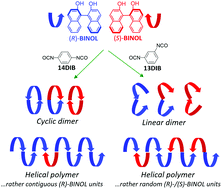Synthesis and stereochemistry of helical polyurethanes based on 2,2′-dihydroxy-1,1′-binaphthyl and diisocyanatobenzenes†
Abstract
Polyaddition between 2,2′-dihydroxy-1,1′-binaphthyl (BINOL) and 1,4-diisocyanatobenzene (14DIB) and that between BINOL and 1,3-diisocyanatobenzene (13DIB) were conducted leading to optically active, helical polyurethanes, poly(BINOL-alt-14DIB) and poly(BINOL-alt-13DIB), respectively. In BINOL-14DIB systems, cyclic dimers were formed along with helical, linear poly(BINOL-alt-14DIB) where the content of dimers was higher at a lower ee of BINOL and the yield of higher-molar-mass, linear polymers was higher at a higher ee of BINOL in feed. (R,R)-, (R,S)-, and (S,S)-Cyclic dimers were completely resolved and separated by chiral HPLC. The (R,S)-cyclic dimer was preferred over (R,R)- and (S,S)-cyclic dimers, while in the reaction using racemic BINOL, the (R,R)-cyclic dimer was preferred over the other isomers at 25–75% ee of (R)-BINOL in feed. Poly(BINOL-alt-14DIB) is proposed to be composed of sequences with rather contiguous (R)-BINOL units as the majority component with rather sporadically incorporated (S)-units as the minor component. Helical sense excess appears to be greater than expected from the ee of BINOL units in the chain, suggesting that (S)-BINOL units sporadically incorporated in a rather contiguous (R)-BINOL unit sequence become a part of the left-handed helical conformation controlled by the chiral influence of contiguous (R)-BINOL units. In addition, the chiral conformation of poly(BINOL-alt-14DIB) and BINOL-14DIB cyclic dimers appeared to be stabilized or enhanced in the solid state. The BINOL-13DIB systems produced linear dimers as major components of the dimer whose content was almost constant regardless of the ee of BINOL in feed. Poly(BINOL-alt-13DIB) is proposed to be composed of sequences with rather randomly distributed (R)- and (S)-BINOL units and may be characterized by sharp, left-handed turns based on BINOL chirality forming a longer-pitched, left-handed helix.



 Please wait while we load your content...
Please wait while we load your content...